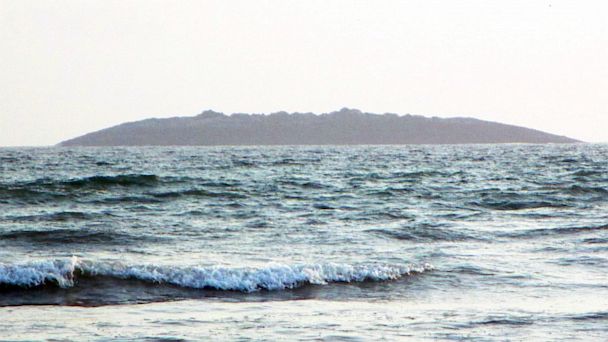New Island Off Pakistan's Coast May Not Stay Afloat

This image shows what appears to be a new island off the coast of Pakistan after the Sept. 24, 2013 earthquake struck the country. (Latif Baloch)
A team of Pakistani researchers took samples today from a new island that mysteriously appeared off the coast following a massive earthquake this week, but warned area fishermen to avoid it and experts said the island may disappear as quickly as it arose.
"There are stones and mud," Pakistani Navy geologist Mohammed Danish told Pakistan's GEO TV. But he said that "Gases are still emitting."
Tufail Baloch, the deputy commission of Gwadar district, told the Associated Press he was among several people who went to the island, described as 60-feet high, 100-feet wide, and 25-feet long. He said water bubbled along the edge of the island, the area smelled of gas and it caught fire when people lit cigarettes.
The island surprised locals who spotted it off the shore after the 7.7 magnitude earthquake that rattled the remote region earlier this week. But geologists said the island could quickly disappear.
"For earthquakes in this part of the world, along the coast of Pakistan and Iran, it's not an uncommon phenomenon," said U.S. Geological Survey research geophysicist Bill Barnhart. He cited earthquake-triggered islands that popped up in 2011, 2001, and 1945 and sank bank into the sea.
"They disappeared because they're large piles of mud that erupt onto the sea floor and rise up above sea level. So with storms, they wash away pretty quickly," Barnhart said. "They're not necessarily made of hard rock. We expect this one will likely be gone within a couple months."
"One of the likely mechanisms for forming the island is a mud volcano eruption, which is caused by the seismic waves of the earthquakes, which makes gases more buoyant and it erupts onto the surface," Barnhart said.
"No one knows why most of these islands appear," said Rob Mellors, a seismologist at Lawrence Livermore National Laboratory. "Usually pressure builds up and they appear one day. It's a bit of a mystery."
Mellors said it is common for mud volcanoes to bubble up bits of gas. "It would be safe to go on one of these islands."
"There is nothing exceptionally unique about this one, other than it was triggered by a far away earthquake directly, which is rare," he said.
Barnhart was doubtful about the presence of methane gas, however.
"The methane in this region we know about are deeper and off shore. It's not the most likely scenario," he said. "It could also be carbon dioxide, fluids in the ground. It's not necessarily methane."
Besides creating an island, the quake killed at least 327 and leveled some villages in the region.
U.S. Geological Survey Geophysicist Don Blakeman said there could be more danger posed by the earthquake.
"Because this is a very big and shallow earthquake, we're going to continue to have aftershocks," said Blakeman. "Some of them might be of substantial size. We can't predict after shocks much better than we can predict earthquakes, so that's a thing to be aware of. Particularly buildings that are already damaged are going to be vulnerable."